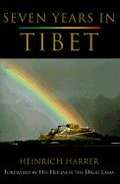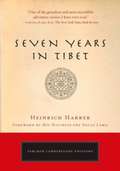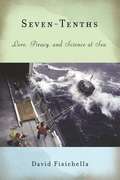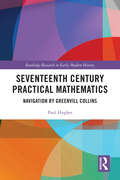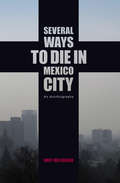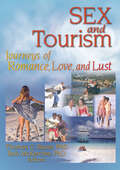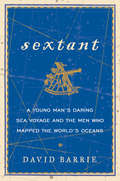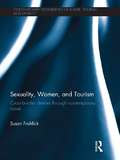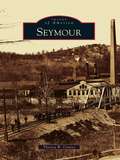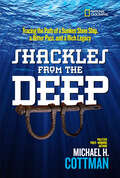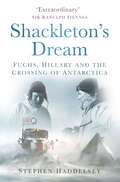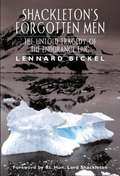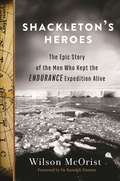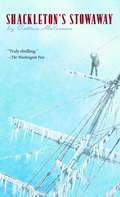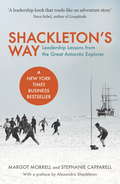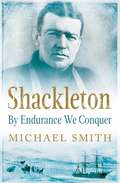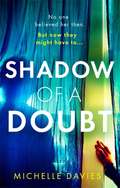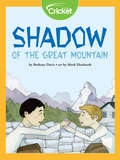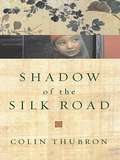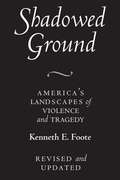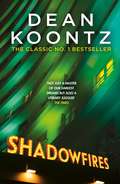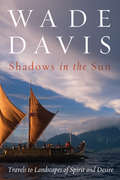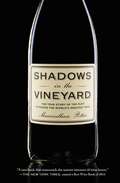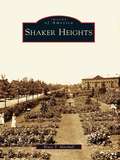- Table View
- List View
Seven Years in Tibet
by Heinrich Harrer Richard GravesThe true adventures of Herr Harrer who spent 7 years in the Himalayan country after escaping an internment camp in 1943.
Seven Years in Tibet
by Heinrich HarrerHeinrich Harrer, already a famous mountaineer and Olympic ski champion, was caught by the outbreak of World War II while climbing the Himalyas. Being an Austrian, he was interned in India. On his third attempt, he succeeded in escaping from the internment camp and fled into Tibet. After a series of experiences in a country never crossed before by a Westerner, Harrer reached the Forbidden City of Lhasa. He stayed there for seven years, learned the language and acquired a greater understanding of Tibet and the Tibetans. He became friend and tutor to the young Dalai Lama and finally accompanied him into India when he was put to flight by the Red Chinese invasion. This film tie-in edition includes an epilogue from the author describing his return to Tibet in the 1990s.
Seven-tenths: Love, Piracy, and Science at Sea
by David FisichellaA disillusioned man and a blind oceanographer find love and adventure while studying the world's oceans.
Seventeenth Century Practical Mathematics: Navigation by Greenvill Collins
by Paul HughesThis exciting Greenvill Collins biography is about seventeenth century navigation, focusing for the first time on mathematics practised at sea. This monograph argues the Restoration kings’, Charles II and James II, promotion of cartography for both strategy and trade. It is aimed at the academic, cartographic and larger market of marine enthusiasts. Through shipwreck and Arctic marooning, and Dutch and Spanish charts, Collins evolved a Prime Meridian running through Charles’s capital. After John Ogilby’s successful Britannia, Charles set Collins surveying his kingdom’s coasts, and James set John Adair surveying in Scotland. They triangulated at sea. Subsequently, Collins persuaded James to sustain his dead brother’s ambition. This, the British coast’s first survey took six years. After James’s flight, and William III’s invasion, Collins lead the royal yacht squadron for six years more, garnering funds to publish Great Britain’s Coasting Pilot. The Admiralty and civic institutions subsidised what became his own pilot. Collins aided Royal Society members in their investigations, and his new guide remained vital to navigators through the century following. Charles’s cartographic promotion bloomed the most spectacularly in the atlases of Ogilby, Collins and John Flamsteed for roads, harbours, and stars.
Several Ways to Die in Mexico City
by Kurt HollanderIn the '80s, when author/photographer Kurt Hollander lived in New York and published The Portable Lower East, life there was particularly rough, and cops often drove yellow cabs as a method to surprise and roust its residents. Before the decade ended, Hollander moved to the equally rough climes of Mexico City, making his living writing and photographing for The Guardian, The New York Times, Los Angeles Times, and many other publications. Hollander's visual and textual extravaganza, Several Ways to Die in Mexico City, provides a perspective of this extraordinary city that could only have been caught by an observant outsider who lived in all its nooks and crannies for over two decades. Crammed with caustic but fair observations of the city's history, food, cults, drugs, and buildings, Hollander proves that he can love a city and culture that also kills its inhabitants softly. While living high in Mexico City, Kurt Hollander edited poliester, the renowned bilingual art magazine about the Americas. He also directed the feature film Carambola, and wrote a successful series of children's books. Grove Press published the Portable Lower East Side anthology in 1994.
Sew Cuddly: 12 Plush Minky Projects for Fun & Fashion—Tips & Techniques to Conquer Cuddle
by Judy GauthierLearn to sew with plush fabrics and faux fur just as easily as any other substrate using Judy Gauthier's expert tips! Keep velvety fabrics from stretching and shedding, plus discover how to appliqué, add binding, and insert a zipper as you sew useful, stylish accessories, quilts, home decor, and cool gifts for kids, all from minky cuddle fabrics. Twelve projects include fashionable animal hats, a clutch purse, a sleeping bag, and a vintage-inspired fox stole.
Sex and Tourism: Journeys of Romance, Love, and Lust
by Thomas Bauer Bob Mckercher Kaye Sung ChonExplore the complex relationship between tourism and intimacy in this new book with a worldwide perspective! With a unique combination of academic and personal accounts, Sex and Tourism: Journeys of Romance, Love, and Lust takes you behind the scenes with motel owners, adventure travel guides, backpackers, and others working on all sides of the international tourism industry. The editors have created a model that views the situation from three different perspectives: tourist, tourism provider, and nature of the encounter. Unlike other related volumes, this book is not just about the sex trade, but also about the role of tourism in love, marriage, and relationships. The global focus of Sex and Tourism will introduce you to: off-season romance on the island of Crete sex tourism in Cambodia a South Korean museum dedicated to women forced into sexual slavery by the Japanese military the sexual aspects of adventure travel in Canada cross-cultural marriage in Thailand gentleman's clubs in New Orleans Australian river guides and their potential liaisons with clients People who travel to escape their day-to-day lives often become involved in situations they would never find themselves in at home. Good or bad, many of these situations are examined in Sex and Tourism. You'll learn about the illegal trafficking of girls in Nepal, worldwide programs for combating child sex rings, and the lethal combination of AIDS and tourism, but you'll also find accounts of love and romance far from home. You will see how the tourism industry can act as a facilitator of human intimacy and what happens when different cultural realities collide. Anyone involved in recreation, leisure, anthropology, social science, or tourism will be interested in this book. Sex and Tourism is an enlightening guide to the complex world found at the crossroads of sightseeing and sex.
Sextant: A Young Man's Daring Sea Voyage and the Men Who Mapped the World's Oceans
by David BarrieAward–winning author David Barrie explores the history of the Sextant and the daring mariners who used it to explore, conquer, and map the world.Since its invention in 1759, a mariner’s most prized possession has been the sextant. A navigation tool that measures the angle between a celestial object and the horizon, the sextant allowed sailors to pinpoint their exact location at sea.David Barrie chronicles the sextant’s development and shows how it not only saved the lives of navigators in wild and dangerous seas, but played a pivotal role in their ability to map the globe. He synthesizes centuries of seafaring history and the brave sailors who have become legend, including James Cook, Matthew Flinders, Robert FitzRoy, Frank Worsley of the Endurance, and Joshua Slocum, the redoubtable old “lunarian” and first single-handed-round-the-world yachtsman. He also recounts his own maiden voyage, and insights gleaned from his experiences as a practiced seaman and navigator.In the tradition of Dava Sobel’s Longitude, David Barrie’s compelling and dramatic tale of invention and discovery is an eloquent elegy to one of the most important navigational instruments ever created. Full of heroism, danger, and excitement, told with an infectious sense of wonder, Sextant examines a masterful achievement that changed the course of history.
Sexuality, Women, and Tourism: Cross-Border Desires through Contemporary Travel (Contemporary Geographies of Leisure, Tourism and Mobility #35)
by Susan FrohlickThis book is the first to focus on why and how foreign Western women engage in cross-border sexual and intimate relations as tourists travelling, or temporarily dwelling, in a Central American country. As an in-depth ethnographic account, the book traces the experiences of heterosexual North American and European women’s transnational encounters, and examines new sexual and social practices arising from contemporary global tourism, shifting sexual cultures both at home and abroad, consumer culture, and women’s increasing mobility. The book combines descriptions of women’s travels and sexual relations across racial and class boundaries with feminism, postcolonial theory, and poststructuralist theories of gender and sexuality, to show how tourism as a wide range and set of desires serves as a central shaping force in the formation of women’s sexual subjectivities in contemporary life in postindustrial capitalism. In doing so it offers new insights into how tourist women express heterosexuality shaped by gender, race, class, and identities. This fascinating book, focusing on the structure of tourism and role of local culture and social organization in the shoring-up of desire, develops a unique contribution to the understanding of sex tourism. It will be of interest not only to tourism scholars, but also to those interested in sexuality, anthropology, sociology, cultural studies, women studies, gender studies, and geography.
Seymour
by Theresa W. ConroyEarly in its history, Seymour was a thriving Native American fishing community along the banks and falls of the Naugatuck River. As European settlers arrived, agriculture dominated the landscape. During the early days of the Industrial Revolution, Seymour flourished as a manufacturing community, and its products were in demand throughout the world. The first woolen mill in the United States was established at the falls by Gen. David Humphreys, who was aide-de-camp to Gen. George Washington. It has been said that his mill produced some of the finest wool in the entire country. The Kerite Company remains the longest-standing manufacturer in Seymour, producing electrical cable used in oil drilling and other areas. Today Seymour is one of the seven towns that make up the All American Valley.
Shackles From the Deep: Tracing the Path of a Sunken Slave Ship, a Bitter Past, and a Rich Legacy
by Michael H. CottmanA pile of lime-encrusted shackles discovered on the seafloor in the remains of a ship called the Henrietta Marie, lands Michael Cottman, a Washington, D.C.-based journalist and avid scuba diver, in the middle of an amazing journey that stretches across three continents, from foundries and tombs in England, to slave ports on the shores of West Africa, to present-day Caribbean plantations. This is more than just the story of one ship – it's the untold story of millions of people taken as captives to the New World. Told from the author's perspective, this book introduces young readers to the wonders of diving, detective work, and discovery, while shedding light on the history of slavery.
Shackleton's Dream: Fuchs, Hillary and the Crossing of Antarctica
by Stephen HaddelseyIn November 1915, Sir Ernest Shackleton watched horrified as the grinding ice floes of the Weddell Sea squeezed the life from his ship, Endurance. Caught in the chaos of splintered wood, buckled metalwork and tangled rigging lay Shackleton’s dream of being the first man to complete the crossing of Antarctica. Shackleton would not live to make a second attempt – but his dream endured.Shackleton’s Dream tells for the first time the story of the British Commonwealth Trans-Antarctic Expedition, led by Vivian Fuchs and Sir Edmund Hillary. Forty years after the loss of Endurance, they set out to succeed where Shackleton had so heroically failed. Using tracked vehicles and converted farm tractors in place of Shackleton’s man-hauled sledges, they faced a colossal challenge: a perilous 2,000-mile journey across the most demanding landscape on the planet.This epic adventure saw two giants of twentieth-century exploration pitted not only against Nature at her most hostile, but also against each other. Planned as a historic (and scientific) continental crossing, the expedition would eventually develop into a dramatic ‘Race to the South Pole’ – a contest as controversial as that of Scott and Amundsen more than four decades earlier.
Shackleton's Forgotten Men: The Untold Tragedy of the Endurance Epic (Adrenaline Classics)
by Lennard Bickel<p>This is a dramatic true story of Antarctic tragedy and survival among the heroic group that was to lay supplies across the Great Ross Ice Shelf in preparation for the Endurance expedition. Launched by Shackleton (and led by Captain Aenaes Mackintosh), this courageous crew completed the longest sledge journey in polar history (199 days) and endured near-unimaginable deprivation. <p>They accomplished most of their mission, laying the way for those who never came. All suffered; some died. Now Australian writer Lennard Bickel honors these forgotten heroes. Largely drawn from the author's interviews with surviving team member Dick Richards, this retelling underscores the capacity of ordinary men for endurance and noble action.</p>
Shackleton's Heroes: The Epic Story of the Men Who Kept the Endurance Expedition Alive
by Ranulph Fiennes Wilson McoristThe Unbelievable Story of Six Men Who Trekked Across the Great Ice Barrier in Support of Ernest Shackleton's Antarctic ExpeditionOne hundred years ago, Sir Ernest Shackleton embarked on the legendary 1914-1917 Imperial Trans-Antarctic Expedition, defying the odds and accomplishing one of history's most remarkable feats of endurance while narrowly escaping death, even though his crew failed in their mission to cross Antarctica. His story, inflated by time and celebrity, has come to personify the Heroic Age of Antarctic Exploration.Less well known, however, is the incredible but often forgotten tale of the Mount Hope Party (also known as the Ross Sea party)-six men who worked in the shadow of Shackleton's greater cause. Sent to the opposite side of the Polar continent, these men dropped life-saving food and fuel depots across the Great Ice Barrier, ensuring that Shackleton had the supplies necessary to complete his mission. Unaware of Shackleton's own failed task, the party persevered in their mission, facing insurmountable obstacles of life on the ice-exhaustion, starvation, and crippling frostbite-risking their lives for the safety of his.Stitching together the previously unpublished diaries of these unsung heroes, McOrist documents their pain and suffering, as well as the humor and camaraderie necessary for their survival. An incomparable record of sheer heroism and tragedy, Shackleton's Heroes tells a story that history ought to remember-one of the indomitable human spirit in the most extreme conditions.
Shackleton's Stowaway
by Victoria McKernanOn October 26, 1914, Ernest Shackleton’s Endurance set sail from Buenos Aires in pursuit of the last unclaimed prize in exploration: the crossing of the Antarctic continent. The crew stood on deck to watch the city fade away. All but one. Eighteen-year-old Perce Blackborow hid below in a locker. But the thrill of stowing away with the legendary explorer would soon turn to fear. Within months, the Endurance, trapped and crushed by ice, sank. And even Perce, the youngest member of the stranded crew, knew there was no hope of rescue. If the men were to survive in the most hostile place on earth, they would have to do it on their own. Victoria McKernan deftly weaves the hard-to-fathom facts of this famous voyage into an epic, edge-of-your-seat survival novel.
Shackleton's Way: Leadership Lessons from the Great Antarctic Explorer
by Stephanie Capparell Margot MorrellSir Ernest Shackleton has been called 'the greatest leader that ever came on God's earth, bar none' for saving the lives of the twenty-seven men stranded with him on an Antarctic ice floe for almost two years. Written by two veteran business observers, Shackleton's Way details universal leadership tactics set against the thrilling survival story of the Endurance expedition. Whether it's hiring good workers, supporting and inspiring employees to do their best, managing a crisis with limited personnel and resources, creating order out of chaos, or leading by personal example with optimism, egalitarianism, humour, strength, ingenuity, intelligence and compassion, Ernest Shackleton set an example we can all follow. Illustrated with photographer Frank Hurley's masterpieces and other rarely seen photos, Shackleton's Way is filled with fascinating and practical lessons of a leader who succeeded by putting people first and triumphing brilliantly when all the odds were against him.
Shackleton: By Endurance We Conquer
by Michael SmithAn extraordinary character and one of history's great explorers, Ernest Shackleton pioneered the path to the South Pole over 100 years ago, becoming the dominant figure in Antarctic discovery. His incredible adventures on four expeditions to the Antarctic have captivated generations. A restless adventurer from an Irish background, he joined the Empire's last great endeavor of exploration - conquering the South Pole with Robert Falcon Scott on the Discovery expedition. A clash with Scott led to Shackleton being ordered home and started a bitter feud between the two. Shackleton's riposte was the Nimrod expedition, where he uncovered the route to the Pole and honed his acclaimed leadership skills, which later kept despair at bay and encouraged men to overcome unimaginable hardship on the Endurance Expedition of 1914. But Shackleton was a flawed character whose chaotic private life, marked by romantic affairs, unfulfilled ambitions, and failed business ventures, contrasted with his celebrity status as the leading explorer. Drawing on extensive research of original diaries, letters, and many other publications, Michael Smith brings a fresh perspective to the Heroic Age of Polar Exploration that was dominated by Shackleton's complex, compelling, and enduringly fascinating story.
Shadow of a Doubt: The twisty psychological thriller inspired by a real life story that will keep you reading long into the night
by Michelle Davies'Pure suspense, where past and present collide with chilling results' Erin Kelly'A hugely entertaining, fast-paced thriller' Caz Frear'It's a pitch-perfect blend of ghostly terror and pacey thriller' Catherine Ryan Howard'Dark, spooky and brilliantly plotted, the perfect read for dark winter nights' Harriet TyceTwenty-six years ago my brother was murdered in my family home.I was sent to a psychiatric unit for killing him.The truth is, I didn't do it.The whole world believed eight-year-old Cara killed her younger brother on that fateful night. But she blamed it on a paranormal entity she swears was haunting her house.No one believed her and after two years of treatment in a psychiatric unit for delusional disorder, Cara was shunned by her remaining family and put into foster care.Now she's being forced to return to the family home for the first time since her brother's death, but what if she's about to re-discover the evil that was lurking inside its walls?
Shadow of the Great Mountain
by Bethany DavisIn this adventurous tale of historical fiction, Edward Whymper's struggle to scale the Matterhorn results in triumph and loss, and inspires courage in a young blind friend. As an old man, Emile Favre tells how this famous mountain climber's quest led him to dream beyond his small village in Italy.
Shadow of the Silk Road
by Colin ThubronShadow of the Silk Road records a journey along the greatest land route on earth. Out of the heart of China into the mountains of Central Asia, across northern Afghanistan and the plains of Iran and into Kurdish Turkey, Colin Thubron covers some seven thousand miles in eight months. Making his way by local bus, truck, car, donkey cart and camel, he travels from the tomb of the Yellow Emperor, the mythic progenitor of the Chinese people, to the ancient port of Antioch-in perhaps the most difficult and ambitious journey he has undertaken in forty years of travel. The Silk Road is a huge network of arteries splitting and converging across the breadth of Asia. To travel it is to trace the passage not only of trade and armies but also of ideas, religions and inventions. But alongside this rich and astonishing past, Shadow of the Silk Road is also about Asia today: a continent of upheaval. One of the trademarks of Colin Thubron's travel writing is the beauty of his prose; another is his gift for talking to people and getting them to talk to him. Shadow of the Silk Road encounters Islamic countries in many forms. It is about changes in China, transformed since the Cultural Revolution. It is about false nationalisms and the world's discontented margins, where the true boundaries are not political borders but the frontiers of tribe, ethnicity, language and religion. It is a magnificent and important account of an ancient world in modern ferment.
Shadowed Ground: America's Landscapes of Violence and Tragedy
by Kenneth E. FooteShadowed Ground explores how and why Americans have memorialized - or not - the sites of tragic and violent events spanning three centuries of history and every region of the country. For this revised edition, Kenneth Foote has written a new concluding chapter that looks at the evolving responses to recent acts of violence and terror, including the destruction of the Branch Davidian compound at Waco, Texas, the Oklahoma City bombing, the Columbine High School massacre, and the terrorist attacks of 9/11.
Shadowfires: Unbelievably tense and spine-chilling horror
by Dean KoontzWhat do you do when there's nowhere left to run? Dean Koontz's Shadowfires is a thrilling novel of jealousy, danger and the fight for survival. Perfect for fans of Stephen King and Harlan Coben.'Tumbling, hallucinogenic prose... 'Serious' writers... might do well to examine his technique' - The New York Times Book Review Rachael Leben's violently possessive ex-husband, Eric, hideously mangled in a freak accident, is dead. But his body has disappeared from the city morgue.Now someone, or something, is watching Rachael. Calling her. Stalking her. And though no one will believe her, she knows who it is; that his walking corpse is a grotesque mockery of life, and his brilliant, warped mind, once again 'alive', is seething with jealous rage, seeking an unspeakable revenge. What readers are saying about Shadowfires: 'This book is a 'once-you-start-you-can't-put-it-down' exhilarating reading experience''This novel is exceptionally brilliant''This book is entertaining, spine-tingling, and utterly terrifying as the possibilities become ever more real...'
Shadows in the Sun: Travels to Landscapes of Spirit and Desire
by Wade DavisWade Davis has been called "a rare combination of scientist, scholar, poet and passionate defender of all of life's diversity." In Shadows in the Sun, he brings all of those gifts to bear on a fascinating examination of indigenous cultures and the interactions between human societies and the natural world. Ranging from the British Columbian wilderness to the jungles of the Amazon and the polar ice of the Arctic Circle, Shadows in the Sun is a testament to a world where spirits still stalk the land and seize the human heart. Its essays and stories, though distilled from travels in widely separated parts of the world, are fundamentally about landscape and character, the wisdom of lives drawn directly from the land, the hunger of those who seek to rediscover such understanding, and the consequences of failure. As Davis explains, "To know that other, vastly different cultures exist is to remember that our world does not exist in some absolute sense but rather is just one model of reality. The Penan in the forests of Borneo, the Vodoun acolytes in Haiti, the jaguar Shaman of Venezuela, teach us that there are other options, other possibilities, other ways of thinking and interacting with the earth." Shadows in the Sun considers those possibilities, and explores their implications for our world.
Shadows in the Vineyard: The True Story of the Plot to Poison the World's Greatest Wine
by Maximillian PotterWhen Maximilian Potter went to Burgundy to report for Vanity Fair on a crime that could have destroyed the Domaine de la Romanée Conti-the tiny, storied vineyard that produces the most expensive, exquisite wines in the world-he soon found a story that was much larger, and more thrilling, than he had originally imagined. In January 2010, Aubert de Villaine, the famed proprietor of the DRC, received an anonymous note threatening the destruction of his priceless vines by poison-a crime that in the world of high-end wine is akin to murder-unless he paid a one million euro ransom. Villaine believed it to be a sick joke, but that proved a fatal miscalculation; the crime was committed and shocked this fabled region of France. The sinister story that Potter uncovered would lead to a sting operation by top Paris detectives, the primary suspect's suicide, and a dramatic trial. This botanical crime threatened to destroy the fiercely traditional culture surrounding the world's greatest wine. Like Midnight in the Garden of Good and Evil, SHADOW IN THE VINEYARD takes us deep into a captivating world full of fascinating characters, small town French politics, an unforgettable narrative, and a local culture defined by the twinned veins of excess and vitality and the deep reverent attention to the land that run through it.
Shaker Heights (Images of America)
by Bruce T. MarshallShaker Heights achieved international renown in the early 20th century as an enclave for wealthy residents--a city of stunning homes, substantial green space, an excellent school system, and attentive municipal services. Cleveland entrepreneurs O. P. and M. J. Van Sweringen established Shaker Heights as a haven from the stresses of city life and claimed a connection with previous residents of this land, the North Union settlement of Shakers. Shaker communities sought to create paradise on earth by living communally and focusing on the life of the spirit. Buyers in Shaker Heights were assured that their paradise would last forever because of restrictions on what could be built and who could live there. Nevertheless, Shaker Heights has changed from a protected environment for the wealthy to a stable, integrated city that intentionally promotes diversity in its population. This is a remarkable story of dramatic change but also continuity as residents pursue the goal of creating an ideal community.
